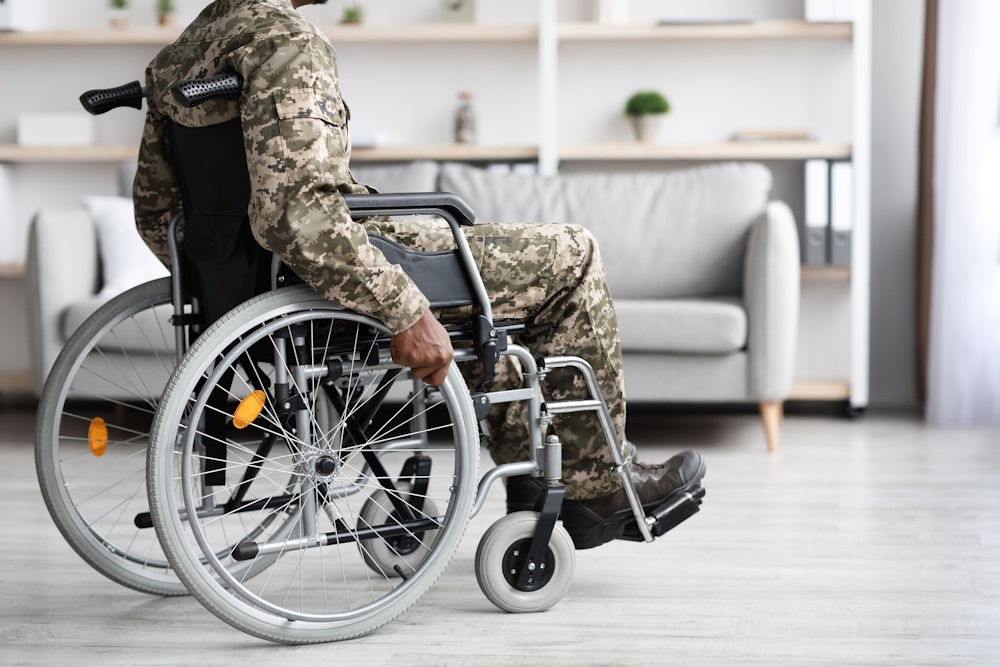Veterans who have a 70 percent VA disability might be eligible for certain benefits. A special system is used to calculate a veteran’s disability rating and takes combined disabilities into account. Read on to find out more about 70 percent VA disability benefits.
Overview of the VA Disability Rating System
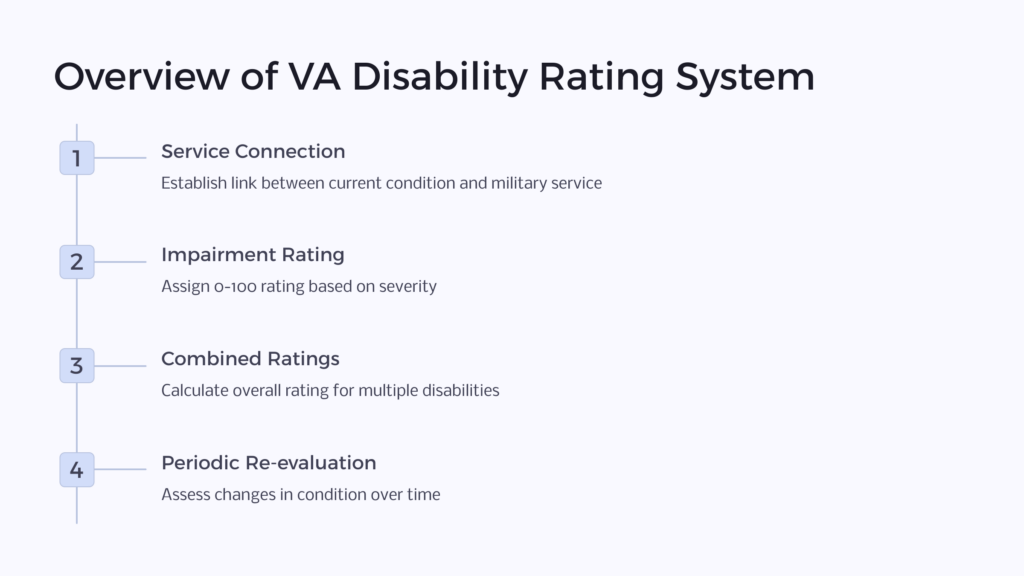
The United States Department of Veterans Affairs (VA) assesses disabilities and determines disability ratings through the VA’s Schedule for Rating Disabilities (VASRD). The VASRD is a comprehensive set of guidelines that assigns disability ratings based on the severity of a veteran’s service-connected disabilities. Here are the key factors that contribute to the overall disability rating:
Service connection
To receive VA disability benefits, a veteran must establish a connection between their current condition and an injury, illness, or event that occurred during their military service.
Impairment rating
Each service connected disability is assigned an impairment rating on the Veterans Affairs disability scale. These ratings fall between 0 to 100, in increments of 10. More severe disabilities receive higher ratings.
Combined ratings
If a veteran has multiple service-connected disabilities, the VA uses a formula to calculate the overall disability rating and benefit amount.
Severity of symptoms
The severity of symptoms associated with a particular disability is a critical factor in determining the disability rating. Medical evidence, including examination reports and relevant medical records, is used to assess the impact of the disability on the veteran’s daily life and ability to work.
Occupational and social impairment
The VASRD considers how a disability affects a veteran’s ability to perform activities of daily living, including work. This assessment takes into account the impact on occupational and social functioning.
Periodic re-evaluation
Disability ratings are not necessarily permanent. In some cases, the VA may schedule periodic re-evaluations to assess whether a veteran’s condition has improved, worsened, or remained stable.
Extra-schedular ratings
In certain cases where the VASRD does not adequately account for the impact of a disability on an individual veteran, the VA may assign an extra-schedular rating. This is an additional or higher rating determined based on the unique circumstances of the case.
Special considerations
Certain disabilities, such as those related to post-traumatic stress disorder (PTSD) or traumatic brain injury (TBI), may have specific criteria and assessment processes to determine the appropriate disability rating.
Decoding the 70 Percent Disability Rating
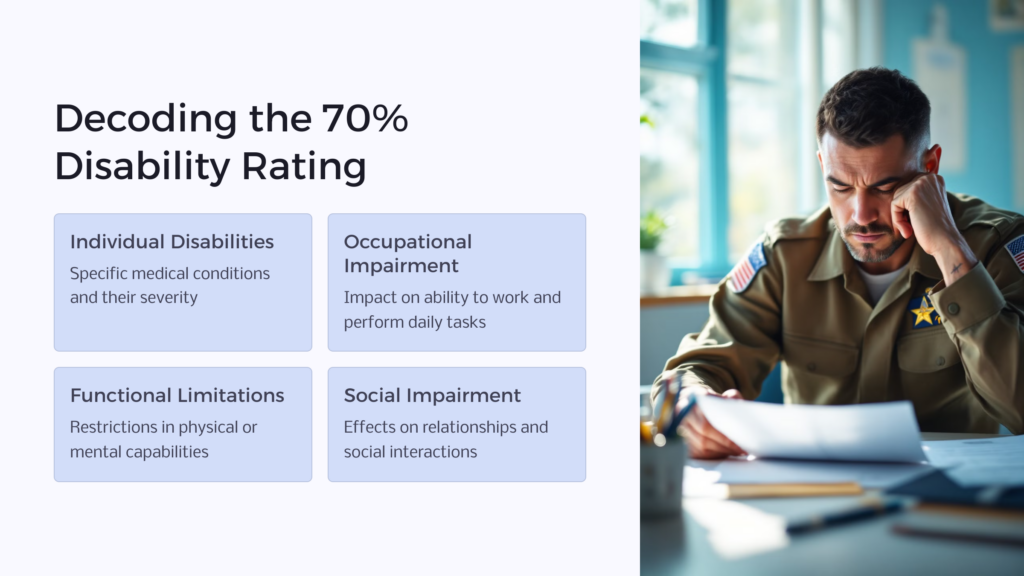
The criteria for a 70 percent VA disability rating and any potential VA disability compensation may vary based on the specific medical conditions and impairments assessed by Veterans Affairs. Please note that these disability criteria may be subject to change, so it’s essential to refer to the latest VA guidelines or consult with a VA representative for the most up-to-date information.
Here are some general principles that could contribute to a 70 percent VA disability rating:
· Individual disabilities.
· Impairment in occupational functioning.
· Specific medical conditions.
· Functional limitations.
· Treatment requirements.
· Social and occupational impairment.
It’s important to note that the specific criteria for a 70 percent VA disability rating can vary based on the nature of the medical conditions and the individual circumstances of the veteran. Additionally, the VA periodically updates its rating criteria, so it’s advisable to consult the latest resources or seek guidance from a VA representative for the most accurate and current information.
Understanding Combined Disability Ratings
The VA’s rating system takes into account the impact of multiple disabilities on a veteran’s overall ability to work and function. The process involves several steps and considerations:
Individual disabilities evaluation
Veterans undergo medical examinations to assess the severity of each service connected disability.
The results of these examinations, along with supporting medical evidence, are used to establish the initial disability ratings for each condition.
Combined ratings table
The VA uses a Combined Ratings Table to combine individual disability ratings. This table considers the degree of disability for each condition and provides a single, overall disability rating.
The combination is not a simple sum of percentages but follows a formula designed to account for diminishing returns as disability levels increase.
Consideration of the ‘Bilateral Factor’
In cases where a veteran has disabilities affecting paired organs or extremities (e.g., both eyes, both knees), the VA may apply a “bilateral factor” to account for the interdependence of these conditions. This can result in a higher combined disability rating.
Special Monthly Compensation (SMC)
Veterans may be eligible for a Special Monthly Compensation rate in addition to their regular disability compensation if they have specific, more severe disabilities. SMC is intended to provide additional compensation for exceptional circumstances, such as the loss of use of a limb or organ.
Total Disability Individual Unemployability (TDIU)
Veterans who are unable to secure and keep substantially gainful employment due to their service-connected disabilities may be eligible for a Total Disability Individual Unemployability (TDIU) rating.
TDIU allows veterans to receive compensation at the 100% disability rate, even if their combined disability rating is less than 100%.
Impact of a 70 Percent Disability Rating on Benefits
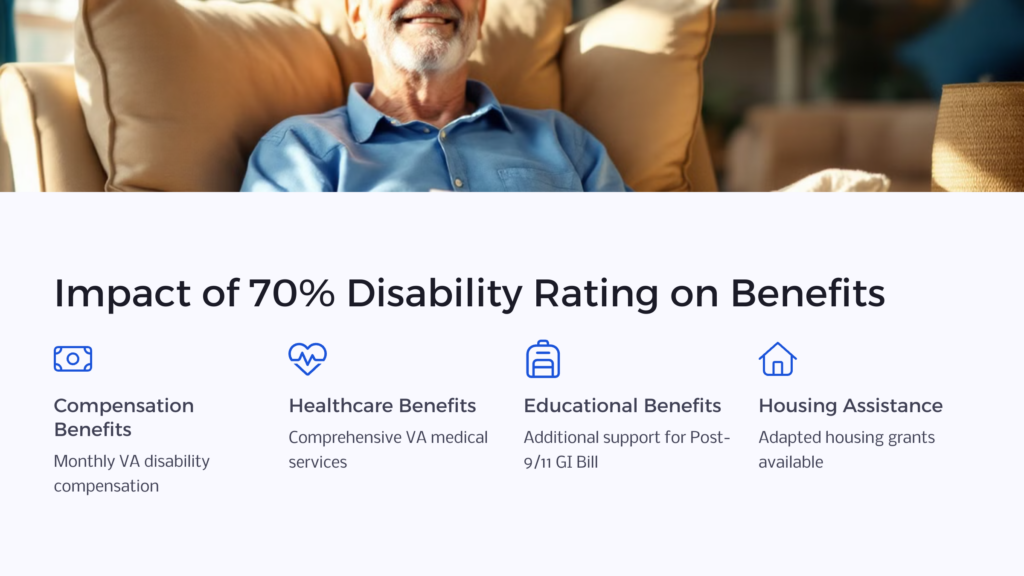
The practical implications of a 70 percent disability rating for veterans can have significant effects on their lives, providing them with various benefits and support. Here are some practical implications and benefits associated with a 70 percent disability rating:
Compensation benefits
Veterans with a 70 percent disability rating are entitled to receive VA disability compensation for disabilities. The compensation amount is determined by the VA and is intended to provide financial support to veterans who are unable to work or face challenges due to their service-connected disabilities.
Healthcare benefits
Veterans with a 70 percent disability rating are eligible for comprehensive healthcare benefits through the VA. This includes access to medical services, prescription medications, and specialized care for their service-connected disabilities.
Vocational Rehabilitation and Employment (VR&E) services
The VA’s VR&E program assists veterans with service connected disabilities in preparing for, finding, and maintaining suitable employment. Veterans rated at 70 percent or higher may qualify for these services to help them re-enter the workforce or pursue new career paths.
Dependents’ benefits
Veterans with a 70 percent disability rating may be eligible for additional compensation if they have qualifying dependents, such as a spouse, children, or dependent parents. The amount can vary based on the number of dependents and their specific circumstances.
Educational benefits
The Post-9/11 GI Bill provides educational benefits to veterans. Veterans with a 70 percent disability rating or higher may qualify for additional financial support, including a higher monthly housing allowance.
Special Monthly Compensation (SMC)
Veterans with severe disabilities may qualify for Special Monthly Compensation, an additional benefit to address the unique challenges associated with certain disabilities. This compensation is in addition to the standard disability compensation.
Housing assistance
Some veterans with a 70 percent disability rating may qualify for adapted housing grants to help them purchase or modify a home to accommodate their disabilities. The Specially Adapted Housing (SAH) and Special Housing Adaptation (SHA) programs are designed for this purpose.
Automobile allowance
Veterans with certain service-connected disabilities may be eligible for an automobile allowance to assist with the purchase of an adaptive vehicle or to cover the cost of modifying an existing vehicle.
Common Misconceptions about 70 Percent VA Disability
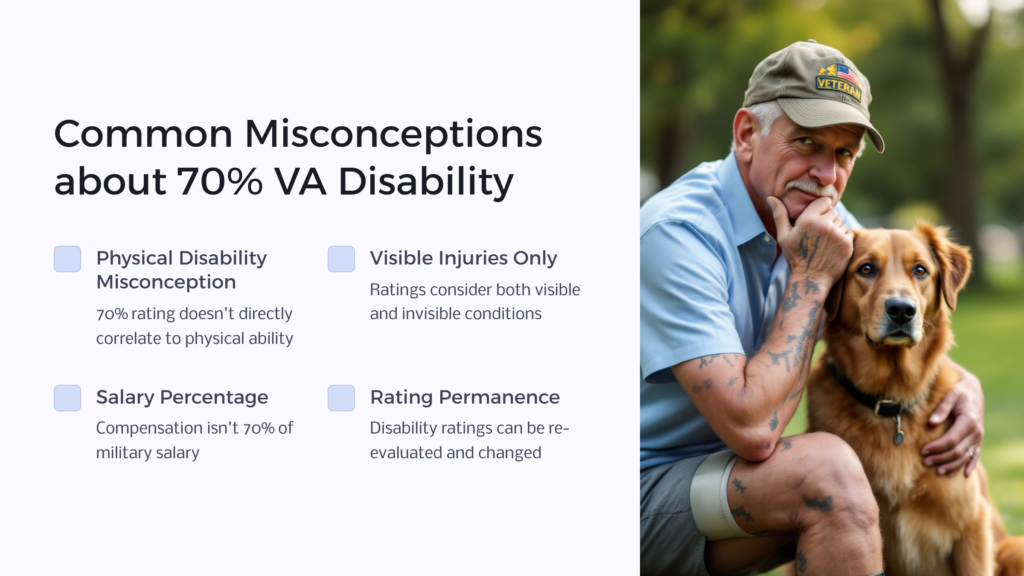
Misconceptions and misunderstandings about a 70 percent disability rating can lead to confusion and misinformation. Here are some prevalent VA disability myths, along with clarifications:
Misconception:
A 70 percent disability rating means the individual is 70 percent physically disabled.
Clarification:
The disability rating assigned by the Department of Veterans Affairs (VA) does not directly correlate with the percentage of physical ability. Instead, it represents the extent to which a service-connected condition affects overall employability and daily life. A 70 percent disability rating indicates significant impairment but does not imply a specific level of physical capability.
Misconception:
A 70 percent disability rating is only for visible or physical injuries.
Clarification:
Disability ratings consider both visible and invisible conditions. Mental health issues, chronic illnesses, and other non-apparent disabilities can contribute to a 70 percent rating. The VA assesses the impact of all service-connected conditions on an individual’s ability to work and function in daily life.
Misconception:
70 percent disability meant receiving 70 percent of a veteran’s salary.
Clarification:
Disability ratings do not directly determine the monetary compensation a veteran receives. The compensation amount is based on the specific disability rating, the number of dependents, and other factors. A 70 percent disability rating has a different compensation rate than a 50 percent or 100 percent rating, but it is not a percentage of the veteran’s salary during active duty.
Misconception:
A 70 percent rating is not a significant disability.
Clarification:
A 70 percent disability rating is considered a substantial level of impairment. It reflects a serious impact on the individual’s ability to work and engage in daily activities. Veterans with a 70 percent rating may experience challenges that affect their quality of life, and they are eligible for higher compensation to address those difficulties.
Misconception:
A 70 percent rating is the highest possible disability rating.
Clarification:
Disability ratings can go up to 100 percent, with increments of 10 percent. A 70 percent rating is significant, but there are higher levels of disability that reflect more severe impairment. Veterans with a 100 percent disability rating may receive additional benefits, including eligibility for Total Disability Individual Unemployability (TDIU).
Misconception:
Once assigned, a disability rating is permanent and cannot be changed.
Clarification:
Disability ratings can be re-evaluated by the VA, especially if there are changes in the veteran’s medical condition or if new information becomes available. Veterans can request a re-evaluation if they believe their condition has worsened, and the VA may adjust the rating accordingly.
Navigating the VA Disability Appeal Process
If a veteran disagrees with their disability rating from the Department of Veterans Affairs, they have the right to appeal the decision. The appeals process can be complex, so it’s essential to understand the steps involved. Here is a general guide on what veterans can do if they disagree with their disability rating:
Review the Decision Letter
Carefully read the decision letter sent by the VA explaining the reasons for the assigned disability rating.
Pay close attention to the evidence and reasoning provided by the VA.
Ask for a debriefing
Request a debriefing with the VA regional office to discuss the decision and get a better understanding of the basis for the rating.
This can provide insights into the specific evidence considered and the VA’s interpretation of the facts.
Consult with a Veterans Service Officer (VSC)
Contact a Veterans Service Officer, who can assist with the appeal process. VSOs are trained advocates who work with veterans to navigate the VA rating system.
Organizations such as the Disabled American Veterans (DAV), Veterans of Foreign Wars (VFW), and the American Legion often have accredited representatives who can help.
Gather supporting evidence
Collect additional medical records, treatment notes, and other evidence that supports your claim for a higher disability rating.
Obtain expert opinions from healthcare professionals if necessary.
File a Notice of Disagreement (NOD)
To initiate the appeals process, file a Notice of Disagreement (NOD) with the VA. This is a formal statement indicating your disagreement with the decision.
Be sure to include specific reasons for the disagreement and any additional evidence you have.
Choose the Appeals Process
The VA offers several options for the appeals process, including the Supplemental Claim Lane, Higher-Level Review Lane, and Appeal to the Board of Veterans’ Appeals.
Choose the option that best suits your situation and preferences.
Submit supporting documents
If pursuing the Supplemental Claim Lane, submit any new and relevant evidence to support your case.
For the Higher-Level Review Lane, request that a more experienced adjudicator review your existing evidence.
If opting for an appeal to the Board of Veterans’ Appeals, submit a substantive appeal and any additional evidence.
Attend a board hearing (optional)
If you choose to appeal to the Board of Veterans’ Appeals, you have the option to request a hearing before a Veterans Law Judge.
Wait for a decision
The appeal process can take time, so be patient. You will receive a decision from the VA once your case has been reviewed.
Consider further appeals if necessary
If still dissatisfied with the decision, there are additional avenues for appeal, including the Court of Appeals for Veterans Claims and the U.S. Court of Appeals for the Federal Circuit.
Understanding the nuances of disability ratings is crucial for veterans to navigate the benefits system accurately. Veterans should seek guidance from VA representatives, veterans organizations (like benefits.com and Trajector), or legal professionals for personalized assistance based on their specific circumstances.
 Benefits.com Advisors
Benefits.com Advisors
With expertise spanning local, state, and federal benefit programs, our team is dedicated to guiding individuals towards the perfect program tailored to their unique circumstances.
Rise to the top with Peak Benefits!
Join our Peak Benefits Newsletter for the latest news, resources, and offers on all things government benefits.















